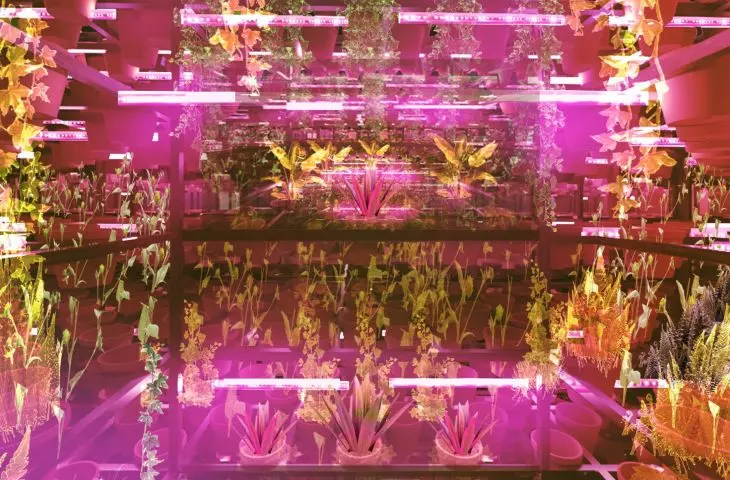"Unknown Unknowns.An Introduction to Mysteries." This is the slogan under which the 23rd edition of the Milan Triennale of Decorative Arts and Contemporary Architecture, curated by Ersilia Vaudo Scarpetta, diversity director of the European Space Agency, will begin on July 15. How will the Polish pavilion fit into this mysterious theme?
Under the motto of the Milan triennale, which is full of unknowns, is a space for open and interdisciplinary discussions about the future of the planet and an attempt to seek answers to various questions about, as the event's organizers write, what we still "don't know that we don't know."
© Triennale Milano
The exhibition in the Polish pavilion has a no less intriguing title - "Greenhouse Silent Disco" is an unusual greenhouse that will give us a better understanding of the world of plants, allowing them to "speak". The installation was created on the initiative of the Adam Mickiewicz Institute and the Museum of Architecture in Wroclaw as part of the ongoing Year of Polish Romanticism. Its curators are Malgorzata Devosges Cuber and Michal Duda of the Wroclaw MA, the authors of the installation are Barbara Nawrocka and Dominika Wilczynska of miastopracownia, and the graphic identification - Nicola Cholewa in cooperation with Magdalena Heliasz.
According to the Museum of Architecture, the shape of the exhibition was influenced by the work of Professor Hazem Kalaji, a plant physiologist from the Warsaw University of Life Sciences, who developed a method to monitor the condition of plants and ecosystems.
It (the exhibition) has been equipped with digital sensors connected to computer systems that will continuously track and record all that plants "say," that is, how they respond to certain needs and variables, such as human presence or changing weather conditions outside. "The 'speech' of the plants will be understood through the changing colors of the LED lights, as well as the sounds into which the computer systems will translate it," the curators explain.
What do you think the plants will tell us?
The authors of the exhibition - Barbara Nawrocka and Dominika Wilczynska from Miastopracownia - talk about the "Greenhouse Silent Disco" project.
Ola Kloc: Please tell us a little about your idea for the arrangement of this unusual greenhouse.
Dominika Wilczynska: This year the pavilion will be filled with plants. We are building the structure out of wood, and planting the plants in clay pots, specially designed for the occasion and hand-rolled. The modular structure will fill the entire space of the pavilion. We want the plants to surround us from all sides. It will be their world, and we are just guests there.
The architecture of the pavilion responds to the curatorial concept, in which the main idea is the communication of plants with the outside world. On the one hand, it's a reference to Romanticism, where the natural world gained its subjectivity, and on the other it's completely contemporary thinking, where an ecological approach is the only right way.
© Museum of Architecture in Wroclaw
Ola: The theme of the triennial is - in free translation - unknown unknowns. How does your proposal fit into this motto?
Barbara Nawrocka: The concept of the Polish pavilion is based on research currently being conducted at the Warsaw University of Life Sciences on chlorophyll fluorescence. The detector system reads the information emitted by plants during photosynthesis. That is, in the simplest terms - plants have their own language and can tell us what conditions (i.e. temperature or humidity) are optimal for them. On the one hand, we have hard data here, but this innovative system for studying plant comfort seems to have opened up some completely new, previously unknown area of science. On the other hand, our human experience in the pavilion will appeal to intuition and the senses. Just being with the plants, whose reactions take place on completely different time scales than ours, the human ones, and Justyna Stasiowska's sounds, into which the plants' messages will be translated, probably appeal more to feeling than to the eye and glass.
Ola: At the center of the exhibition, as you emphasize, are plants, not people. Did creating spaces for plants surprise you with anything? Or did you discover some new aspects that, when designing for people, you don't pay as much attention to?
Dominika Wilczynska: Actually, in the whole process of working together with Malgorzata Devosges Cuber and Michal Duda of the Museum of Architecture in Wroclaw, the curators of the exhibition, with each successive decision we asked ourselves "But will it be good for plants?". When designing for non-human subjects, much more attention is paid to what you can't see: temperature, humidity, waves emitted by various types of detectors or resistance to the constant presence of a crowd of visitors. The main difference is that people will only pass through there, so we provide them with a minimum width of passage. The plants will be there for six months, so they must have designed comfort for longer.
Ola: Thank you for the interview.















